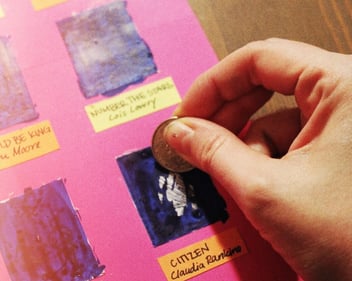by Lisa Hiton

As a Boston University undergraduate, I tried my pen at BU’s newspaper, The Daily Free Press. I learned quickly that I was not suited to be a journalist: I could never figure out how to be dispassionate about any subject. Even the first film I was assigned to review, Rent, led to quite an editorial quagmire: I so loved the music and content of Rent that I wrote a glowing review of a supremely mediocre-at-best attempt at cinema. My editor also snagged a ticket and had seen the film. Without my knowing it, she decided to turn my small review into a feature—a full-blown editor-versus-writer side-by-side review of Rent: hers in which she ripped the film apart, next to my overly sentimental tribute. And so, my trial at journalism never took off and my editor had me writing reviews—books, music, films, restaurants, and cultural pieces—for my entire tenure at the “Freep”.
Opinion writing reminds readers and communities that actions large and small impact people—for better and for worse. And it is in the context of our own scenes that these opinions arise. The responsibility of journalists is to report the news in a non-biased way. And yet, journalistic institutions—from newspapers to online-only endeavors—have expanded to also include op-ed pieces. As technology advances, our relationship to information continues to evolve. And as the public demands more content, writers and thinkers participate in the larger story: in articulating how they feel about the information of our realities, no matter how small or large.
In this sense—by the inclusion of feeling—op-eds are antithetical to journalism. Op-ed writers are responsible to the subjective. The facts of the world force individuals and communities to abide by governing forces. Op-ed writers can remind the public of our subjective contexts, needs, and emotions. While a journalist may report solely on the passing of a new law or repealing of an old one, an op-ed writer also explores how a given community is impacted by such a decision. Opinion writing has the opportunity to spark real change because of the emotional intuitions of op-ed writers.
We can see the critical importance of opinion pieces by reading the headlines about the Holocaust that were published during WWII. “Nazis Hint Purge in Poland” is a straightforward way for the NY Times reporter to give the public the facts about what was happening abroad. The article from September 13, 1939 opened with the following statements: “First intimations ‘that a solution of the 'Jewish problem’ in Poland is on the German-Polish agenda are revealed in a 'special report’ of the official German News Bureau.” Given the report’s claim that Polish Jewry “continually fortified and enlarged” Western Jewry, the Times correspondent added, it was hard to see how their “removal” would change things “without their extermination.” In these statements, the reporter does not address the morals behind the motivation of the Nazis. While this abides the rules of a journalism, a more passionate writer or orator may feel that being non-biased, given the circumstances, is morally reprehensible.
Setting Your Scenes
News and media legacy, Conrad C. Fink, champions the importance of scene setting in op-ed writing in his book Writing Opinion for Impact. The opening section of the book, “Setting the Scene”, contains three chapters dedicated to helping writers understand the op-ed writing genre and the responsibilities that come with the role. The opening of this section reads:
The first thing to learn in opinion writing is that you must unlearn one thing probably central to your idea of what a journalist is all about.
You’ve picked it up in journalism courses: A journalist must stay out of the story, stay objective, stay dispassionate. Right?
Well, that was then—in reporting or newswriting courses—not now, when you must move from objective to subjective writing, when you must insert your ideas and your emotions into your writing, not eliminate them.
A second lesson up front is that if you think newswriters have impact on how the world turns, think of yourself as an opinion writer, bursting into the marketplace of ideas backed by the institutional prestige and power of a newspaper or magazine or the international reach of cyberspace.
No matter the size of your publication, it likely will be one of the most influential institutions in your community. And, when you enter cyberspace, the world is your theater.
(Fink, 1)
Setting the scene is about understanding your new role when faced with the blank page and your responsibilities to your chosen subject as well as your readership. Even if you’re writing an op-ed for Write the World, you will have a community of writers and readers who stand to be influenced by your ideas.
Fink’s first section goes on to show burgeoning opinion writers that setting the scene involves knowing: “The Responsibilities of Opinion Writers”, “Identifying Issues for Comment”, and “Reporting and Researching Your Opinions”. Once you learn what’s at stake and heart in this genre, the rest of the book gets into the nitty-gritty of how to write opinion pieces for different outlets—newspapers, magazines, columns, criticism, etc.
Writing Opinion for Impact by Conrad C. Fink: Whether you’re writing for a school paper or an online magazine, Fink’s text is for readers of all levels who want to learn how their opinions can be turned into writing that may just influence a community. Fink’s book focuses on the nuanced differences between journalists and opinion writers, rules of the opinion writing genre, and guiding writers through the process of writing successful opinion pieces, whether they’re interested in cultural reviews, local politics, or anything else.
We the Media: Grassroots Journalism by the People, for the People by Dan Gillmor: To pair with Fink’s step-by-step approach to op-ed writing, We the Media is an outstanding introduction to “new media”, covering the many forums opinion writing may occupy in an increasingly digital world. Especially as journalism, blogging, and even social media become our means of communication, Gillmor’s book explicates how we’ve gone from, as he puts it, “Tom Paine to Blogs”. The entire nature of journalism and what the public expects has changed in so many ways. This is a central text for op-ed writers at any and every stage.
Op-Ed Book Recommendations
There are many hot-topics at this moment which op-ed writers are focused on. From the #metoo and #TimesUp movements to local causes, op-ed writers are using their passions in conjunction with research to help communities get motivated into action.
“Helping gifted children is all very well–but what about the rest?” by Dawn Foster: This opinion piece takes on a recent BBC show, Generation Gifted, which follows “gifted” children at various schools. As this writer points out, this attention on specific students by the producers is as loud as their ignoring the fellow students of these “gifted” children.
- Foster asks a huge question of readers in this piece: “ If the ‘gifted’ children are struggling even with individual attention, and as much support as their parents can give them, what happens to the rest?” Why does Foster pose this as a question instead of a statement? How/why is this a useful tool of the opinion writing genre?
“A Spy’s Guide to Climate Change” by Justin Gillis: Climate change is, unfortunately, a hotly politicized topic. My use of the word “unfortunately” in this context suggests an opinion. What opinion do I have if this is the tone I take in writing about climate change? Gillis, in this piece, is far more helpful to readers, providing clear information about how a spy views the Trump Administration’s approach (or lackthereof—see, I did it again…another opinion in my tone) to withdrawing from the Paris Act.
- How does Gillis format his opinion piece? Why?
- What role do facts play in this piece? How does research unveil Gillis’ motivation in writing this opinion piece?
“We’re entitled to eat safe meat. Why has that become such a lottery?” by Felicity Lawrence: While food issues may not always be at the forefront of the news amid the madness of contemporary politics, genocide, refugee issues, and the rest, food safety and ethics are topics that nevertheless engender passionate debate. Lawrence’s piece addresses the systems which regulate (often unsuccessfully) the quality of meat purchased by consumers.
- What facts did you learn about food safety? Will this op-ed influence your behavior and food consumption (purchasing or eating) in future trips to the grocery store or to a restaurant? How might this piece encourage you to talk to your parents about their food shopping habits?
- To what extent is this op-ed biased? To what extent does it maintain non-biased journalism?
As you read through these op-ed pieces and others, here are some questions that can help guide your reading and annotating experience so that you can read like an op-ed writer:
- Where in this piece does the reader receive unbiased information?
- Where does the writer’s opinion reveal itself?
- How does the writer fit into the story of the subject?
So dear writers, as you begin crafting your op-ed, know that your passionate opinions may change the minds of your readers and inspire them into action; your passionate opinion may just help to change our communities and the world at large for the better.
About Lisa
Lisa Hiton is an editorial associate at Write the World. She writes two series on our blog: The Write Place where she comments on life as a writer, and Reading like a Writer where she recommends books about writing in different genres. She’s also the interviews editor of Cosmonauts Avenue and the poetry editor of the Adroit Journal.





